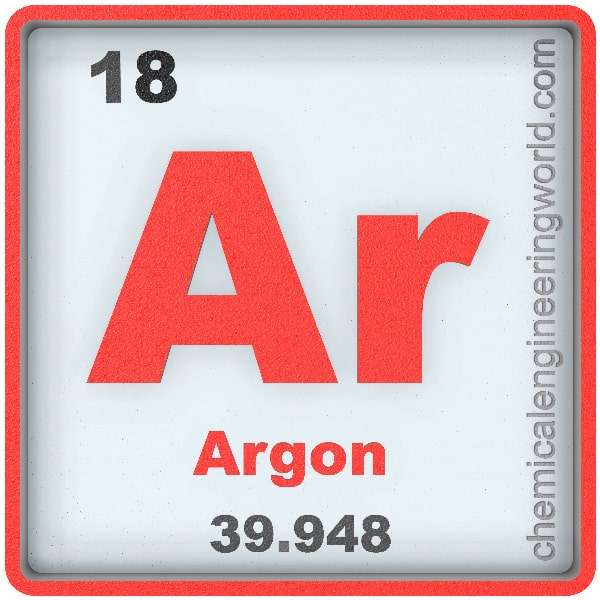Argon Element Properties and Information

Argon Element Properties and Information:
Argon is eighteenth element on the periodic table. Elements are arranged in the periodic table on the basis of the atomic number. Atomic number is the number of protons in the nucleus of the atom. Argon has an atomic number of 18. It is located in the Group 18 and Period 3 of the periodic table of elements. It is denoted by Ar. The name is derived from the Greek word ‘Argos’ which means Idle.
Henry Cavendish had noted in 1785 that 1% of air won’t react with any material even under most extreme condition. That 1% of air was argon. Lord Rayleigh and William Ramsay are credited for being first to separate argon from air in 1894. They did it by first removing oxygen from air and then reacting the extracted air with magnesium which resulted in solid magnesium nitride, this step removed all nitrogen from air leaving behind argon.
Argon is the third most abundant atmospheric gas on earth and makes up about 0.94% of the total atmosphere. The levels of argon are gradually increasing because because radioactive potassium-40 decays to form argon.
Physical Properties:
- Argon is a colourless and odourless gas which is totally inert to other elements and also non-flammable and non-toxic.
- The atomic mass of argon is 35.453
- The melting point of argon is -189°C
- The boiling point of argon is -185.7°C
- The density of argon is 1.78 in S.I. units at 0°C
- Argon has three main isotopes on earth; argon-36, argon-38, and argon-40. Among these argon-40 makes up to about 99.6% of the total argon present on earth.
- Argon has almost same solubility in water as oxygen and it is more than twice as soluble as nitrogen.
- Argon has low thermal conductivity.
Chemical Properties:
- Argon has been demonstrated to form argon fluorohydride which is stable only below 17 K temperature.
Methods of Production:
- Distillation of Air: Industrially, argon is produced worldwide by the method of fractional distillation of liquid air. The separation happens in a cryogenic unit which separates liquid nitrogen which boils at 77.3 K from liquid argon which boils at 87.3 K from liquid oxygen which boils at 90.2 K.
Relevance in Chemical and Related Industries:
- Inert Atmosphere: Argon is used as an inert atmosphere in some high temperature industrial applications.
- Pharmaceutical industries: High purity chemicals and formulations are sometime sealed in argon environment which increases their life span.
Relevance in Other Industries:
- Food Industries: Argon displaces oxygen and moisture from a space hence it is used as a preservative gas in order to increase the shelf life of food packaging. Hydrolysis, aerial oxidation and other chemical reactions which could degrade the quality of food products are significantly reduced or entirely eliminated.
- Medicine: Argon is used in argon-enhanced coagulation which is a form of argon plasma beam electrosurgery. Cryoablation use argon to destroy cancer cells. Argon lasers are used to weld arteries, destroy tumours and correct eye defects.
- Lighting: Argon gas is filled in incandescent light bulbs in order to prevent the filament from oxidising at high temperatures.
Health Effects on Exposure:
- Asphyxiation: Argon is relatively more denser than air thus breathing argonwill displace the oxygen with argon and thus lead to asphyxiation. Since they are tasteless and odourless, the effect becomes visible when mental alertness is diminished and hand eye coordination is impaired.
Effects on Surroundings:
No known harmful effects on surroundings are known.
References:
































